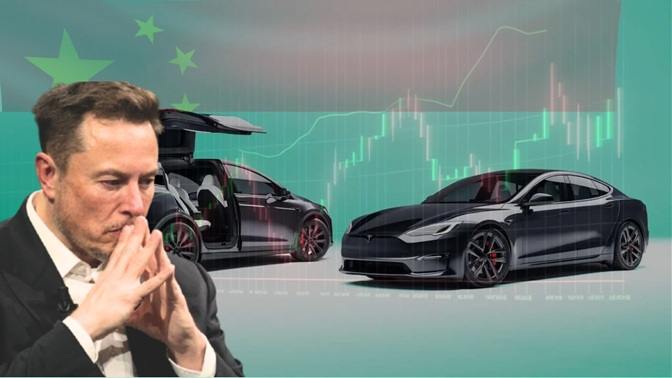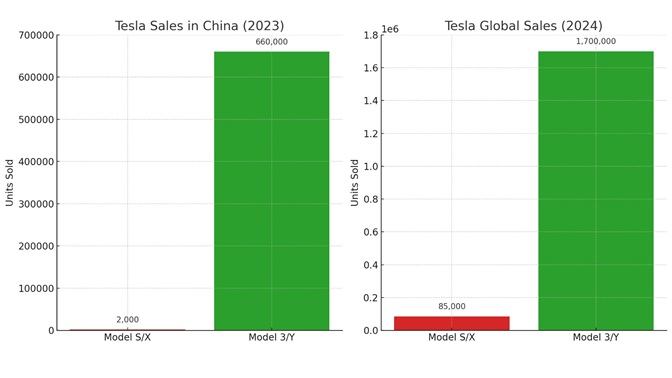There was a time when the Tesla Model S and Model X were the crown jewels of the electric vehicle world. The S was a sleek, game-changing luxury sedan, and the X brought jaw-dropping falcon-wing doors and room for the whole family. For many, these two EVs represented the future of driving. Fast forward to today, and their story is taking a different turn.

Tesla has stopped taking new orders for the Model S and Model X in China, the world’s biggest electric vehicle market. There wasn’t a big announcement or flashy press release—just a quiet update on Tesla’s Chinese website that removed the ordering options for both models. And just like that, Tesla’s once-flagship EVs moved one step closer to the end of the road. Let’s dive into why this is happening, what it means, and what it says about how fast the EV world is evolving.
Orders Closed in China
Tesla’s decision to stop selling new Model S and Model X vehicles in China isn’t random. While customers can still buy leftover inventory, no new units are being shipped into the country anymore.
Why? It comes down to tariffs, low demand, and fierce local competition.
China has imposed high tariffs on American-made EVs, and since the Model S and X are only built in Fremont, California, they’ve become expensive and less appealing to Chinese buyers. On top of that, Tesla’s local rivals, like BYD, are offering more affordable and often more tech-savvy models that appeal more to the local market. In 2023, Tesla sold fewer than 2,000 Model S and X units in China. That’s a tiny number compared to the 660,000+ Model 3 and Model Y sales during the same period. It’s clear where the focus—and the future—lies.
This isn’t just a China-only issue. Tesla has already phased out the Model S and Model X in several markets around the world. Countries with right-hand drive (RHD) cars—like the UK, Japan, and Australia—were among the first to lose access. Customers who had placed orders were offered the chance to switch to a Model 3 or Y, or simply cancel.
Globally, the numbers tell the same story. Tesla stopped releasing individual sales figures for the Model S and X, but we do know this: in 2024, the company grouped the Model S, Model X, and Cybertruck together under an “Other Models” category. Combined, they made up only 85,000 deliveries worldwide. In contrast, the Model 3 and Model Y delivered over 1.7 million units in the same year. That’s more than 20 times as many.
Price and Relevance: Big Problems for Big Cars
One of the biggest challenges for the Model S and Model X is price. The Model S starts at around $80,000, and the Model X costs even more. Sure, they come with impressive performance, sleek design, and premium features—but the competition has caught up, and buyers now have more affordable options that offer just as much excitement and practicality.
Even Tesla’s own Model 3 and Model Y have become the better buys. They offer modern tech, solid performance, and far better value for money. It’s no surprise that they’re dominating Tesla’s sales. And while the Model S did get a significant update in 2021, including the wild yoke-style steering wheel, it still feels like an aging product in a market that moves lightning-fast.
Let’s give credit where it’s due: the Model S and Model X were once revolutionary.
- The Model S proved that EVs could be fast, stylish, and luxurious all at once.
- The Model X added family-friendly features in a futuristic package.

Together, they changed the way people thought about electric cars. Without them, the success of the Model 3 and Y might not have been possible. But now, as EVs go mainstream and buyers demand more affordable, efficient options, Tesla is shifting its focus. These two legacy models are quietly exiting stage left as the company doubles down on volume models like the Model 3, Model Y, and its next-gen vehicles.
Tesla’s future is all about scalability and innovation—and that means making EVs that more people can afford.
- The Model Y continues to lead the charge as Tesla’s global best-seller.
- The Cybertruck is Tesla’s wild card, targeting the pickup market.
- And the upcoming next-gen platform aims to lower costs and speed up production even more.
As Tesla looks ahead, it’s clear that the focus is on models that can reach millions, not just thousands. Unfortunately, the Model S and X no longer fit into that plan.
The Tesla Model S and Model X were once the EV dream cars—symbols of innovation and progress. But today, they’re becoming more of a legacy than a priority. Tesla isn’t making a big fuss about it. No dramatic farewell. Just quiet website updates and shrinking availability. It’s a reminder that in the world of electric vehicles, technology moves fast—and the market moves even faster.
If you’ve always admired the Model S or X, you still might find one in Tesla’s inventory. But it’s clear that their time in the spotlight is over. And that’s okay—because their legacy lives on in every electric car that followed.
Related Post
